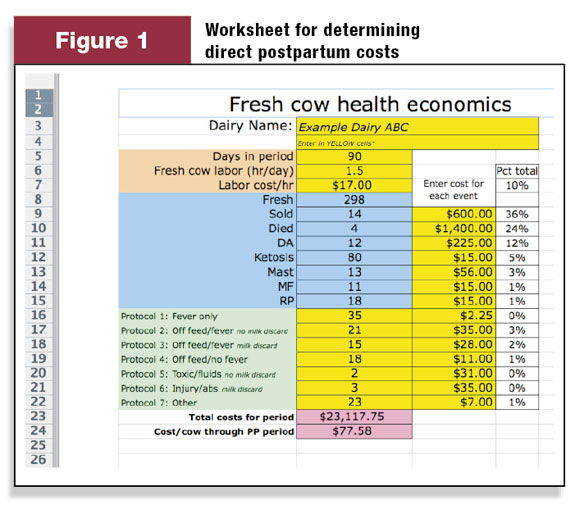Of all the important areas to monitor on a dairy, management of the entire transition period (3 weeks pre- and 3 weeks post-freshening) can have a huge impact on lactation performance and profit per cow. Transition periods that are not optimized pose increased risk of postpartum metabolic and immune- related diseases, early culling and poor reproductive results, all having a potentially significant negative economic impact on your herd. Optimizing the health of postpartum cows is critical to every dairy herd to ensure both production and reproduction goals are met. During the past several years, producers and industry experts have adopted several useful benchmarks to evaluate postpartum health (see Table 1), and as expected, many managers have effectively reached or exceeded them.
However, in addition to reaching numeric benchmarks, the cost of achieving these goals is equally important if managers are focused on maximizing profit per cow.
What are the direct costs in my postpartum program?
The actual cost of a postpartum disease can be difficult and complicated to measure when taking into account the loss of future production, treatment costs, depreciated value of the animal, labor, culling and reproductive losses, to name a few. In addition, many herds do not record all disease events and/or detection capabilities may vary widely, as is the case for diseases like ketosis and mastitis.
An economic evaluation method that producers often find more accessible (and representative of actual cash flow impacts) is to monitor “direct costs,” which include allocated labor costs, treatment and drug costs, and culling costs on a cash transaction basis.

As shown in Figure 1 , it is possible to estimate the direct costs of a cow through its 30-day postpartum period using a simple spreadsheet to capture estimated costs for labor, culling, metabolic events and additional treatment costs (pharmaceuticals and additives) that were not recorded as an event. The spreadsheet is broken down into three sections:
• Dairy Inputs – (orange) Number of days evaluated, total daily labor for postpartum animals and the average hourly labor cost of persons working with the postpartum group.
• Event Inputs – (blue) This section can be populated directly from your herd management software program using the events command. This requires that the dairy has established clear definitions of disease events, diagnoses diseases accurately and lastly, records all events into your program.
• Additional protocols – (green) Those costs are not captured in the above events. Again, this requires that the dairy has clearly defined protocols that are followed consistently and entered into the dairy software program.
Variation between herds
Using the above methods, we’ve recently evaluated postpartum costs on 28 commercial dairies with defined postpartum treatment protocols and assumed average record keeping using their dairy management software.
Postpartum costs included were animals sold and died (assuming cash value replacement cost), recorded metabolic events and average estimated treatment costs and additional postpartum protocols resulting in treatment expense during the previous 3 months.
Estimated postpartum costs per animal ranged from $71.80 to $110.24 across herds. This example dataset reveals in excess of 38 dollars of potential profit per cow if the highest-cost herd were to further evaluate transition health, protocol definitions and drug inventory usage.
That amount of variation is alarming, especially since all of the evaluated dairies considered themselves to have above-average transition programs by industry standards. It is reasonable to assume that the potential profit opportunity is even larger in herds that have yet to reach “industry benchmarks” and is significant amidst the current dairy economic situation.
Opportunities revealed
The wide variation in calculated postpartum costs are only a symptom of the opportunity we uncovered by looking at postpartum performance in combination with an economic metric. The recommendation with these commercial dairies is to examine these key areas:
• Labor – The best dairies spent less than 15 percent of their total postpartum direct costs on labor. This was a balance of allocating enough labor to the group to provide proper care without requiring animals to stand or be locked more than one hour per day. Additionally, these herds had well-defined protocols, allowing herdspersons to quickly and accurately make decisions and administer treatments.
• Diagnostics – Many herds detected very few metabolic diseases, yet treated many cows off-feed. Several herds that reported low levels of clinical ketosis actually had more than 30 percent of fresh cows with elevated blood beta-hydroxybutyrate (BHBA), indicating high herd risk for ketosis, metabolic and reproductive issues. Implementing diagnostic and monitoring tools like cowside BHBA tests allow herds to more accurately diagnose ketosis and provide solutions within their transition programs.
• Protocols – Some of the herds did a great job of recording metabolic events; however, they did not know the cost of treatment or even what pharmaceuticals were routinely used to treat. Their treatment costs were 2X to 3X on a percentage basis compared to the best-managed herds. This presented the opportunity to improve drug inventory management and pharmaceutical expenses from their dairy operations.
Summary of postpartum costs
Successful management of the transition period is critical to subsequent lactation performance. While good managers have been able to successfully reach established industry performance standards, we have found a wide range of postpartum culling, metabolic events and treatment costs which significantly impact profitability per cow.
Producers must accurately record, diagnose and allocate all treatment and labor costs to ensure their postpartum animals reach both high performance and profitability. PD
References omitted due to space but are available upon request to editor@progressivedairy.com.

-
Neil Michael
- DVM
- Vita Plus Corporation
- Email Neil Michael






